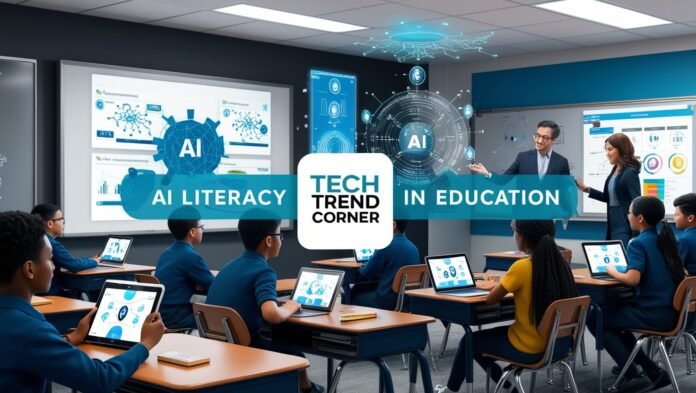One of the most significant changes today is the impact of Artificial Intelligence (AI). AI is no longer a dream; it exists and affects every sector, changing how we live, work, and study. As AI grows in scope and relevance, incorporating AI Education becomes more apparent than ever. This involves shedding more light on AI Education, Educators, and learning institutions, which currently struggle to address emerging AI dynamics.
AI Literacy in Education extends beyond AI usage in schools for students. It also includes designing inclusive practices on AI theory, usage, and global impact. In this article, we will further explain AI Literacy in Education, its relevance, and how to implement it in educational systems.
Understanding AI Engagement in Educational Contexts
In its simplest form, AI Literacy means understanding and operating AI technology while appraising its uses. In education, AI Literacy provides students, Educators, and institutions the elements to understand AI basics, its value, and associated risks.
AI Literacy enhances the educational system by integrating technology into teaching and learning. Whether using adaptive learning software, content-based assessment tools, or chatbots as teaching aides, AI Tools transforms education delivery. However, before these technologies benefit students and Educators, they must understand how AI functions, what it can do, and what it cannot do.
AI Literacy involves learning to use AI-powered Tools and comprehending their significance. In practical terms, the future workforce needs to know how AI operates, its possibilities, and limitations in work situations. Education cannot lag; thus, incorporating AI Literacy elements in education is essential.
Why Ensuring AI Literacy in Education is Worthy
Ensuring AI literacy in education is invaluable as it equips students for tomorrow’s diverse employment sectors where AI is integral. It fosters accommodative learning through personalized AI tools, enhances critical reasoning and problem-solving abilities, and instills ethical awareness for responsible AI usage. Additionally, AI literacy bridges societal and economic gaps, promoting fairness and empowering all learners to thrive in an AI-driven world.
1. Equipping Students for Tomorrow’s Employment Sector
AI quickly integrates into the services industry, emphasizing AI Literacy in education. AI exists globally in sectors like healthcare, banking, movies, and education. Therefore, Educators must equip learners to work with AI and prepare them for future jobs that may not yet exist. In future job markets, people need to understand AI’s significance in business, society, and technology. AI Literacy prepares students to handle these situations.
2. Accommodative Learning
AI-powered Tools create a conducive learning atmosphere for students. These tools monitor and evaluate learning pace, progress, abilities, and difficulties, offering appropriate lessons and activities. To use these tools, students must understand the technology and how to use it. AI Literacy improves the learning experience by enabling responsible AI use.

3. Reasoning and Problem Solving
Developing AI Literacy builds critical and problem-solving skills in learners. As students learn how AI processes data, they can seek solutions to complex issues. This education equips students with tools for future success in a technology-focused society where individuals must invent or develop solutions. Furthermore, AI Literacy encourages students to think critically and question AI systems’ operations and improvements.
4. Ethics and Use of AI
AI raises ethical issues like data privacy, security, bias, and fairness. AI Literacy encourages students to reflect on these ethical concerns and use AI responsibly. As students learn AI’s problems, they develop a vision for using technologies that benefit humanity.
The Pros of Embracing AI Literacy in Schools
Embracing AI literacy in schools offers numerous benefits, including improved learning outcomes through personalized AI-powered tools, enhanced teaching processes by boosting educators’ efficiency, and fostering innovation as students develop and utilize AI technologies. Additionally, it promotes societal and economic justice by reducing educational disparities. These advantages strengthen students, teachers, institutions, and society, creating a more effective and equitable education system.
1. Improved Learning Outcomes
AI-powered tools offer limitless educational delivery possibilities, fostering personalized learning experiences. They adjust content based on student learning styles and available content. Students who learn to use these tools achieve better grades. AI Literacy encourages constructive AI tool use for positive learning results.
2. Enhanced Learning Processes
Teachers can use AI-powered Tools creatively in classrooms to enhance AI Literacy. AI Tools increase teachers’ productivity and effectiveness, from grading assignments to creating non-standard teaching activities. Additionally, Educators can use AI to track student development, identify areas needing help, and provide individual feedback. Thus, technology supports and enhances teachers’ initiatives, improving the education system.
3. Encouraging Innovation
Understanding AI Literacy helps students use and innovate with AI technologies. They can build AI-enabled applications, find solutions to social issues, or work on machine learning models. This translates to advancing technology with their AI comprehension. It fosters innovation in education and beyond, allowing students to explore AI imaginatively and rationally.
4. Societal and Economic Justice
AI Literacy can reduce educational disparities. As life increasingly relies on AI, those who can operate it benefit the most. Integrating AI Literacy addresses gender and socioeconomic challenges related to advanced technology and knowledge. This creates a fairer society where everyone can utilize AI’s benefits.

Introducing AI Literacy in the Curriculum
Integrating AI literacy into the curriculum requires revising course content to include foundational and advanced AI topics across all educational levels. It involves comprehensive teacher training and ongoing professional development to ensure educators are proficient in AI concepts and tools. Collaborations with technology firms provide essential resources and up-to-date technologies, while emphasizing ethical AI use fosters responsible and informed students. This structured approach ensures that AI education is seamless, inclusive, and effectively prepares learners for an AI-driven future.
1. Revision of the Curriculum
Schools must revise course content to include AI-related topics. These topics cover introductory AI concepts and deep learning subjects like machine learning, neural systems, and AI generalization issues. The framework should reach students at all ages, including preschool, primary, and tertiary levels, ensuring a solid AI grounding.
2. Educator Preparation and Ongoing Training
Teachers play a pivotal role in AI Literacy, but many lack adequate AI training. Schools need to provide professional development programs on AI teaching. These programs expose Educators to AI content and challenges, ensuring they can use AI teaching tools confidently.
3. Collaborations with Technological Firms
Working with technological firms provides schools additional resources for AI integration in classrooms. Schools can partner with firms that develop AI Tools-enabled tools and learning platforms. This collaboration allows schools to implement cutting-edge technologies and helps students utilize AI skills, increasing their job prospects in AI sectors.
4. Advocating Responsible AI Use
Incorporating AI Literacy must address ethical AI use. Educators should train students to embrace AI’s positive uses and recognize its dangers. Classroom discussions should include privacy, algorithmic discrimination, and AI’s societal impacts, fostering students’ ethical consciousness.
Challenges to Implementing AI Literacy
Implementing AI Literacy faces several challenges across educational levels. The most significant challenge is the lack of competent teachers to teach AI knowledge effectively. Curriculum enhancements should integrate AI aspects into teaching methods.
Another challenge is the digital gap. Many education systems, especially less favorable environments, cannot provide students with the necessary technology to understand AI. These technology inequalities lead to disparities in AI Literacy education, highlighting the need for equity and access.
Lastly, content creation is a problem. Regardless of the educational sector’s age demographic, suitable and engaging AI content is scarce. Therefore, schools and Educators should collaborate with AI content creators and educational program authors to develop creative and helpful teaching aids.

Conclusion
AI Literacy in education is not merely a trend but a future necessity. As AI technologies rise in all sectors and aspects of life, students and teachers must understand AI, operate AI systems, and recognize the ethical dilemmas AI raises. Integrating AI Literacy into curriculums, training teachers, and advocating ethical AI use will prepare students for a world where AI is essential.
We may face challenges in fully incorporating AI Literacy in education, but the advantages outweigh the obstacles. We support students in grasping new technologies by preparing them for an AI-driven world and equipping them with skills to design, invent, and use AI appropriately. Those who use AI effectively will have a bright future, and we must ensure all learners can adapt to new learning methods without restrictions.
Read more about AI Healthcare Startups: Innovative Solutions Unveiled.
Frequently Asked Questions
1. How can you explain artificial intelligence literacy in the context of education?
AI Literacy means comprehending, utilizing, and critiquing AI systems. It gives students, Educators, and institutions knowledge about AI introduction, uses, advantages, risks, and safe, meaningful AI employment in teaching and learning.
2. Why is AI literacy relevant for students’ future employment?
AI Literacy equips students with skills and knowledge that boost employability, as AI technologies embed in virtually all sectors. It helps them understand how AI interfaces with business, society, and technology, preparing them for current and future AI jobs.
3. In what ways can AI literacy positively affect learning outcomes?
AI Literacy allows students to use individualized AI-powered Tools that fit their learning preferences and needs. This model improves understanding and performance, leading to higher grades and a more practical, enjoyable learning process.
4. What are the advantages of AI literacy to school teachers?
AI Tools-enabled tools make teaching more enjoyable and effective. For example, AI can grade assignments, monitor students, and create suitable teaching activities, enhancing teachers’ productivity and teaching effectiveness.
5. For example, how can curriculum include components of AI literacy?
AI Literacy can integrate by revising curricula to include AI topics, training Educators, collaborating with industries for support, and addressing ethical issues. This ensures AI Education starts at primary levels and continues through university.
6. What are the barriers to promoting AI literacy in education?
Key barriers include unqualified professionals, lack of technology access, and unsuitable AI content for target groups. Overcoming these requires teacher training, ensuring technology equity, and engaging with content developers.
7. How does AI literacy help promote justice in society and economy?
AI Literacy promotes equity by equipping all students to use AI courteously. It fosters fairness by enabling people from all communities to utilize AI technologies, earn a living, and participate in a technology-dependent economy.

